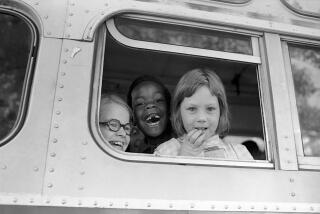Grouping Kids by Age Should Have Vanished With the Little Red Schoolhouse
- Share via
Supporters and opponents of social promotion are fighting last century’s war. Grouping students by age and advancing them in lock step is an artifact of the agrarian calendar and factory model of schooling that emerged in the late 19th century. That it is still with us is a commentary on just how conservative schooling is. If the school clock and calendar once made sense, they no longer do.
It is time to rethink the organization we call school, and with it the very idea of social promotion. (As onetime teachers union head Al Shanker said, if “a quarter of the products don’t work when they reach the end of the assembly line, and a quarter fall off before they get there, it’s time for a new metaphor.”)
As every parent and teacher knows, children’s developmental trajectories vary widely, and the notion of grouping children by age is a convention without meaning. Indeed, in the example of social promotion is it actively harmful.
The child who is held back feels diminished and unsuccessful, but the child promoted beyond his ability is sure to be more frustrated than ever. Both sides of the social promotion debate are losers because they take for granted the antique process of age grouping.
As it is, a full chronological year separates the youngest from the oldest student in each grade, and the developmental difference is often much greater. Nothing is more frustrating to both teachers and students than trying to bridge a huge achievement gap within a single classroom.
The solution is genuinely performance-based instructional grouping, a format that schools must master in the 21st century. In performance-based schools, students would be held to high academic standards and would work to achieve them for as long -- or as little time -- as it took. Indeed, that is the de facto model in high school and college. A student takes Spanish 1 until it’s mastered, then moves on to Spanish 2.
At a more humdrum but no less important level is how most of us master lifetime sports like golf, skiing, tennis and running. We work at it till we get it, and age is only the roughest proxy for achievement. In my last ski-school class, ages ranged from 24 to 63.
In 1993, Pat Graham, former Harvard Graduate School of Education dean, told the National Commission on Time and Learning that for more than a century “time was the constant, learning the variable; in the future we must hold learning high and constant and make time the flexible variable.” It is time to make this vision a reality.
The elementary schools of Beaufort, S.C., are an example of successful multi-age grouping at work; there, students are held to the same high standards, but instruction is organized by achievement level.
Holding a child back at the end of a grade is painful if the school experience is defined in terms of age grouping; if it is defined in terms of performance measures, students can blend social groups across academic lines, just as older and younger siblings do.
The opportunity and the challenge lie in finding ways to permit tracking student performance in real time.
Unlike end-of-course tests, real-time tracking would allow the teacher to intervene when the intervention can work, and the student to learn before falling dangerously behind.
There is no more certain evidence than the social promotion debate that we are still prisoners of time. Breaking out of that prison is the promise of performance-based schools.






